Seismic Performance of Space-Saving Special-Shaped Concrete-Filled Steel Tube (CFST) Frames with Different Joint Types: Symmetry Effects and Design Implications for Civil Transportation Buildings
Abstract
1. Introduction
1.1. Seismic Performance of Special-Shaped CFST Columns
1.2. Research Status of Special-Shaped CFST Frames
1.3. Symmetry Perspective and Relevance to Civil Transportation Engineering
1.4. Objectives and Scope of the Study
2. Experimental Program
2.1. Specimen Design and Configuration
2.2. Material Properties
2.3. Test Setup and Loading Protocol
3. Experimental Results and Discussion
3.1. Observed Failure Modes
3.2. Hysteresis Behavior and Skeleton Curves
3.3. Strength, Stiffness Degradation, and Energy Dissipation
3.4. Strain Distribution and Deformation Analysis
4. Finite-Element Modeling (ABAQUS)
4.1. Model Development
4.1.1. Material Constitutive Models
4.1.2. Element Types and Meshing
4.1.3. Interaction Modeling
4.1.4. Analysis Steps
4.1.5. Boundary Conditions and Loading
4.2. Model Validation
4.3. Numerical Results
5. Fiber-Model Analysis and Parametric Study (OpenSees)
5.1. Fiber Model Description and Validation
5.2. Parametric Analysis
5.3. Design Recommendations
6. Discussion
6.1. Performance of Different Joint Types
6.2. Comparison with Design Codes and Implications
6.3. Engineering and Cost Implications
6.4. On Alternative Infill Materials
6.5. Limitations of the Present Study
6.6. Discussion of Repairability
6.7. Discussion of Axial Load Ratio Effects
6.8. Local Behavior of Joints and Connectors
6.9. Uncertainty and Variability in Seismic Indices
7. Conclusions
- (1)
- Frame-level tests demonstrated that special-shaped CFST frames with external hoops and vertical ribs provide the highest strength and energy dissipation, while fully bolted replaceable-plate joints successfully localized damage and enabled rapid repair.
- (2)
- Stable hysteresis loops with ductility coefficients of 3.03–3.69, equivalent viscous damping ratios of 0.13–0.25, and drift capacities of 0.088–0.126 rad confirm the excellent seismic performance of the tested frames.
- (3)
- A symmetry-based perspective was introduced: cruciform sections and middle-span configurations showed more centrosymmetric hysteresis and slower degradation than L-shaped columns and edge spans, directly linking symmetry to seismic resilience.
- (4)
- Validated ABAQUS and OpenSees models captured the hysteresis and skeleton curves with good accuracy, supporting their use for design and parameter studies.
- (5)
- Parametric analysis defined practical design windows—steel ratio 5–20%, axial load ratio < 0.4–0.5, slenderness ≤ 30, stiffness ratio ≈ 0.36, and beam-to-column flexural capacity ratio ≈1.0—providing deployable guidance for resilient and repairable CFST frame design in transportation buildings.
Author Contributions
Funding
Data Availability Statement
Acknowledgments
Conflicts of Interest
References
- Wang, Z.; Liu, Z.; Zhou, X. Experimental investigation of special-shaped concrete-filled square steel tube composite columns with steel hoops under axial loads. Materials 2022, 15, 4179. [Google Scholar] [CrossRef] [PubMed]
- Yin, X.; Yue, H.; Sun, Y.; Fu, G.; Li, J.; Rahman, M.M. Finite Element Analysis of T-Shaped Concrete-Filled Steel Tubular Short Columns with Stiffening Ribs Under Axial Compression. Buildings 2025, 15, 112. [Google Scholar] [CrossRef]
- Yang, M.; Yu, D.; Qiu, Q.; Yu, Y. Finite element analysis and bearing capacity calculation of cross-shaped CFST columns under compressive load. Heliyon 2024, 10, e28715. [Google Scholar] [CrossRef] [PubMed]
- Tao, Y.; Zhang, S.; Xiong, G.; Gong, C.; Hou, Z.; Li, X. Eccentric Compression Behavior of Truss-Reinforced Cross-Shaped Concrete-Filled Steel Tubular Columns. Materials 2024, 17, 3738. [Google Scholar] [CrossRef] [PubMed]
- Dabaon, M.; El-Boghdadi, M.; Hassanein, M. Experimental investigation on concrete-filled stainless steel stiffened tubular stub columns. Eng. Struct. 2009, 31, 300–307. [Google Scholar] [CrossRef]
- Shen, Y.; Tu, Y. Flexural strength evaluation of multi-cell composite T-shaped concrete-filled steel tubular beams. Materials 2021, 14, 2838. [Google Scholar] [CrossRef]
- Liu, J.; Yu, W.; Fang, Y.; Pan, Z. Experimental study on the seismic performance of concrete-filled steel tube columns with a multiple-chamber round-ended cross-section. Front. Mater. 2024, 11, 1363206. [Google Scholar] [CrossRef]
- Yang, Y.-F.; Han, L.-H. Concrete filled steel tube (CFST) columns subjected to concentrically partial compression. Thin-Walled Struct. 2012, 50, 147–156. [Google Scholar] [CrossRef]
- Wang, R.; Han, L.-H.; Hou, C.-C. Behavior of concrete filled steel tubular (CFST) members under lateral impact: Experiment and FEA model. J. Constr. Steel Res. 2013, 80, 188–201. [Google Scholar] [CrossRef]
- Beng, S.H.; Park, S. EN 1994-Eurocode 4: Design of composite steel and concrete structures. Retrieved May 1994, 10, 2022. [Google Scholar]
- ACI Committee. Building Code Requirements for Structural Concrete (ACI 318-08) and Commentary; American Concrete Institute: Mumbai, India, 2008. [Google Scholar]
- Folić, R.; Radonjanin, V.; Malešev, M. Design and analysis of steel-concrete composite structure. In Introductinary-Invited Paper on 6th Greek National Conference on Metal Structures; Greek Association for Metal Structures: Athens, Greece, 2008; pp. 72–87. [Google Scholar]
- Building Seismic Safety Council. Prestandard and Commentary for the Seismic Rehabilitation of Buildings; Report FEMA-356; Federal Emergency Management Agency: Washington, DC, USA, 2000. [Google Scholar]
- Liang, Q.Q. Strength and ductility of high strength concrete-filled steel tubular beam–columns. J. Constr. Steel Res. 2009, 65, 687–698. [Google Scholar] [CrossRef]
- Hu, J.-W.; Kang, Y.-S.; Choi, D.-H.; Park, T. Seismic design, performance, and behavior of composite-moment frames with steel beam-to-concrete filled tube column connections. Int. J. Steel Struct. 2010, 10, 177–191. [Google Scholar] [CrossRef]
- Dong, X.; Wang, L.; Xu, Z.; Liu, L.; Guan, S.; Chen, H. Cyclic performance of T-Shaped CFST column to steel beam joint with vertical stiffener. Structures 2023, 55, 1659–1674. [Google Scholar] [CrossRef]
- Yang, Y.; Wang, G.; Yang, W.; Wei, X.; Chen, Y.F. Experimental research on fire behavior of L-shaped CFST columns under axial compression. J. Constr. Steel Res. 2022, 198, 107505. [Google Scholar] [CrossRef]
- Zhang, Y.-B.; Han, L.-H.; Zhou, K.; Yang, S. Mechanical performance of hexagonal multi-cell concrete-filled steel tubular (CFST) stub columns under axial compression. Thin-Walled Struct. 2019, 134, 71–83. [Google Scholar] [CrossRef]
- Han, D.; Tao, Z.; Abdul Ghafar, W.; Hasan, M.M.; Xiao, W.; Wang, T.; Zhou, K.; Dai, H. Experimental Study on the Seismic Performance of L-Shaped CFST Columns in Different Combinations. Buildings 2023, 13, 2320. [Google Scholar] [CrossRef]
- Zhang, J.-W.; Tong, J.-Z.; Zhang, L.; Tong, G.-S.; Li, X.-G. Seismic performance evaluation on composite frame structures with T-shaped multi-cellular CFST columns. J. Constr. Steel Res. 2022, 199, 107634. [Google Scholar] [CrossRef]
- Yang, D.-S.; Xue, D.; Xu, H.; Duan, W. Low-cycle fatigue design for reinforced high-strength concrete under high compressive stress. Case Stud. Constr. Mater. 2024, 20, e03078. [Google Scholar] [CrossRef]
- Wang, W.; Lyu, X.; Zheng, J.; Yi, S.; Li, J.; Yu, Y. Post-fire seismic performance of concrete-filled steel tube frame structures considering soil-structure interaction (SSI). Buildings 2024, 14, 555. [Google Scholar]
- Zhang, W.; Sun, S.; Xiong, Q.; Du, Y.; Wang, Y. Macro joint model for progressive collapse analysis of L-shaped CFST column frames. Proc. Inst. Civ. Eng.-Struct. Build. 2025, 178, 280–295. [Google Scholar]
- Yu, C.-Q.; Tong, G.-S.; Tong, J.-Z.; Zhang, J.-W.; Li, X.-G.; Xu, S.-L. Experimental and numerical study on seismic performance of L-shaped multi-cellular CFST frames. J. Constr. Steel Res. 2024, 213, 108360. [Google Scholar] [CrossRef]
- Ren, Q.-X.; Han, L.-H.; Lam, D.; Hou, C. Experiments on special-shaped CFST stub columns under axial compression. J. Constr. Steel Res. 2014, 98, 123–133. [Google Scholar] [CrossRef]
- Yang, Y.; Yang, W.; Tang, X.; Cheng, Y. Seismic behavior of plane frame with special-shaped CFST columns, H-shaped steel beams and vertical rib connections. Structures 2021, 31, 721–739. [Google Scholar] [CrossRef]
- Mou, B.; Li, Y.; Qiao, Q. Connection behavior of CFST column-to-beam joint implanted by steel rebars under cyclic loading. Eng. Struct. 2021, 246, 113036. [Google Scholar] [CrossRef]
- Wang, K.; Yuan, S.-F.; Chen, Z.-X.; Zhi, H.-X.; Shi, G.-L.; Cao, D.-F. Experimental study on hysteretic behavior of composite frames with concrete-encased CFST columns. J. Constr. Steel Res. 2016, 123, 110–120. [Google Scholar] [CrossRef]
- Chen, Z.; Xu, J.; Zhou, T.; Su, J. Seismic research on column base joint of L-shaped CFST columns under cyclic loading. Structures 2022, 45, 1212–1224. [Google Scholar] [CrossRef]
- Kharoob, O.; Ghazy, M.; Yossef, N. Behavior of beam-high performance fiber reinforced CFST column joints. Thin-Walled Struct. 2017, 113, 217–227. [Google Scholar] [CrossRef]
- Zubydan, A.H.; ElSabbagh, A.I. Monotonic and cyclic behavior of concrete-filled steel-tube beam-columns considering local buckling effect. Thin-Walled Struct. 2011, 49, 465–481. [Google Scholar] [CrossRef]
- Liu, J.; Song, H.; Yang, Y. Research on mechanical behavior of L-shaped multi-cell concrete-filled steel tubular stub columns under axial compression. Adv. Struct. Eng. 2019, 22, 427–443. [Google Scholar] [CrossRef]
- Mahmoud, S.; Saleem, M.; Hasanain, A.; El-Sokkary, H.; Elsharawy, M.; Genidy, M.; Abd-Elhamed, A. Structural response and damage evaluation of a typical highrise RC building in Dubai under an earthquake with single and multiple peaks. J. Civ. Eng. Manag. 2022, 28, 509–522. [Google Scholar] [CrossRef]
- Dong, Y.; Zhou, T.; Chen, Z.; Xu, J.; Su, J. Seismic performance of L-shaped exposed column base connections. J. Constr. Steel Res. 2025, 235, 109832. [Google Scholar] [CrossRef]
- Yang, F.; Bao, Y.; Du, M.; Li, X. Numerical Investigation of the Axial Compressive Behavior of a Novel L-Shaped Concrete-Filled Steel Tube Column. Materials 2025, 18, 897. [Google Scholar] [CrossRef] [PubMed]
- Cheng, R.; Hu, C.; Gong, M.; Wang, Y. Behaviors of improved multi-cell T-shaped concrete-filled steel tubular columns under eccentric loads. J. Constr. Steel Res. 2022, 193, 107251. [Google Scholar] [CrossRef]
- Lyu, X.; Li, Y.; Wang, W.; Liu, F.; Xu, Y. Behaviour of T-shaped stiffened concrete-filled steel tubular stub columns after uniform and non-uniform fire exposure. Adv. Struct. Eng. 2024, 27, 72–84. [Google Scholar] [CrossRef]
- Hasan, M.M.; Tao, Z.; Ghafar, W.A.; Huangfu, S.-E.; Zhang, Z. Investigating the axial compressive behavior of cruciform CFST columns: An experimental study. Structures 2024, 69, 107538. [Google Scholar] [CrossRef]
- Zheng, Y.; Lin, Z.; Lin, Y.; Zhang, X. Eccentric compressive behavior of stiffened and multi-cell cross-shaped CFST columns under different loading angles. Thin-Walled Struct. 2025, 217, 113903. [Google Scholar] [CrossRef]
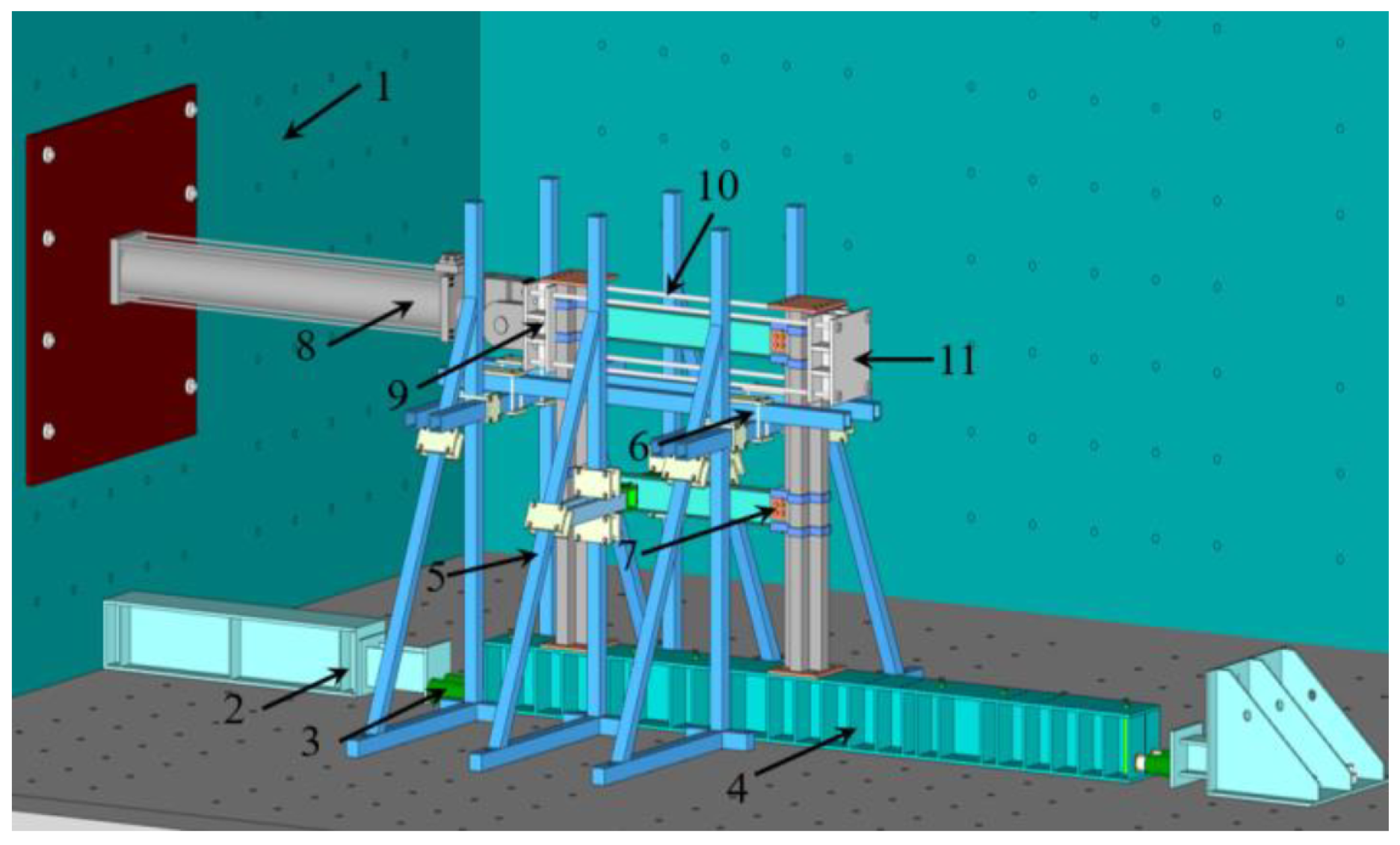


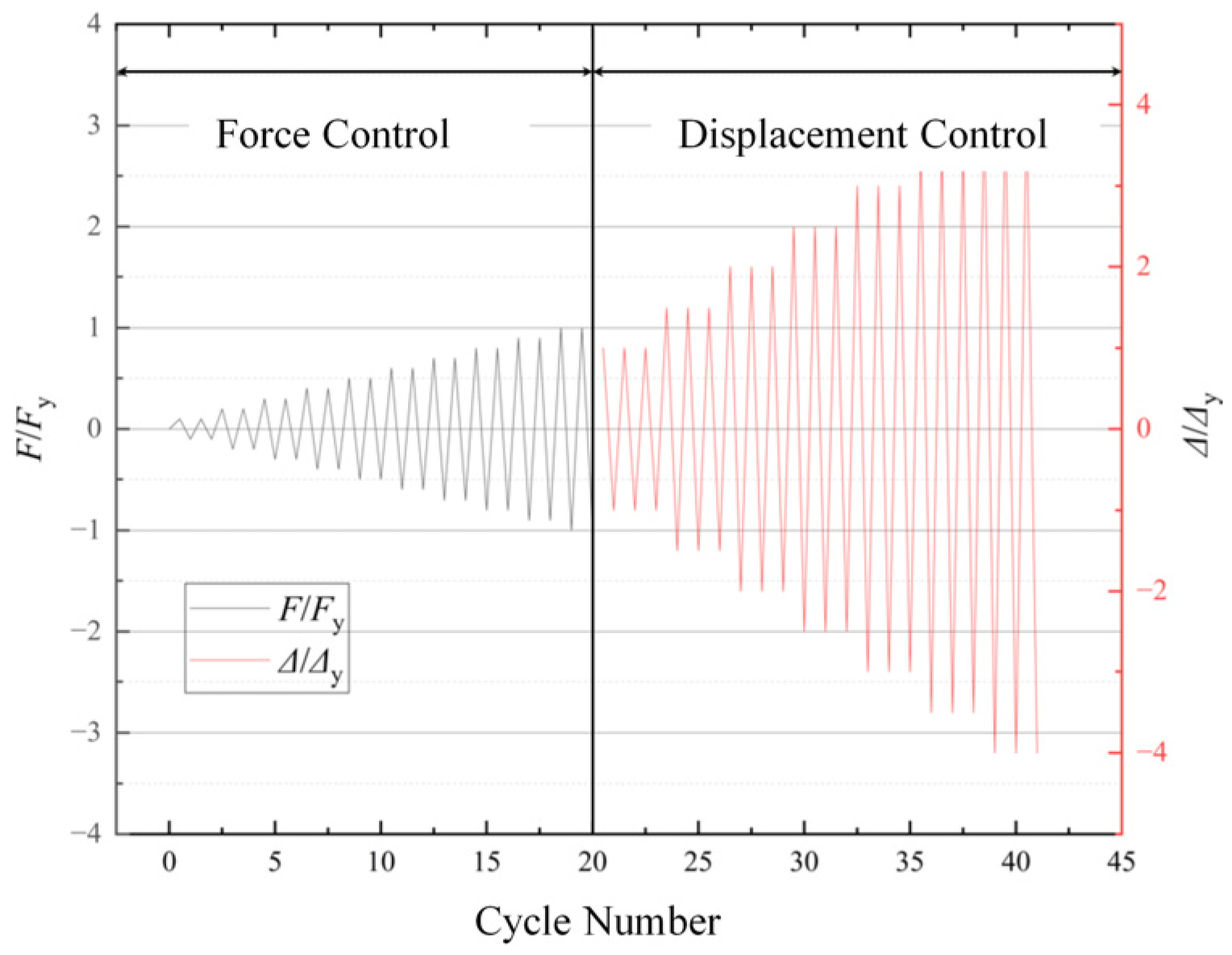
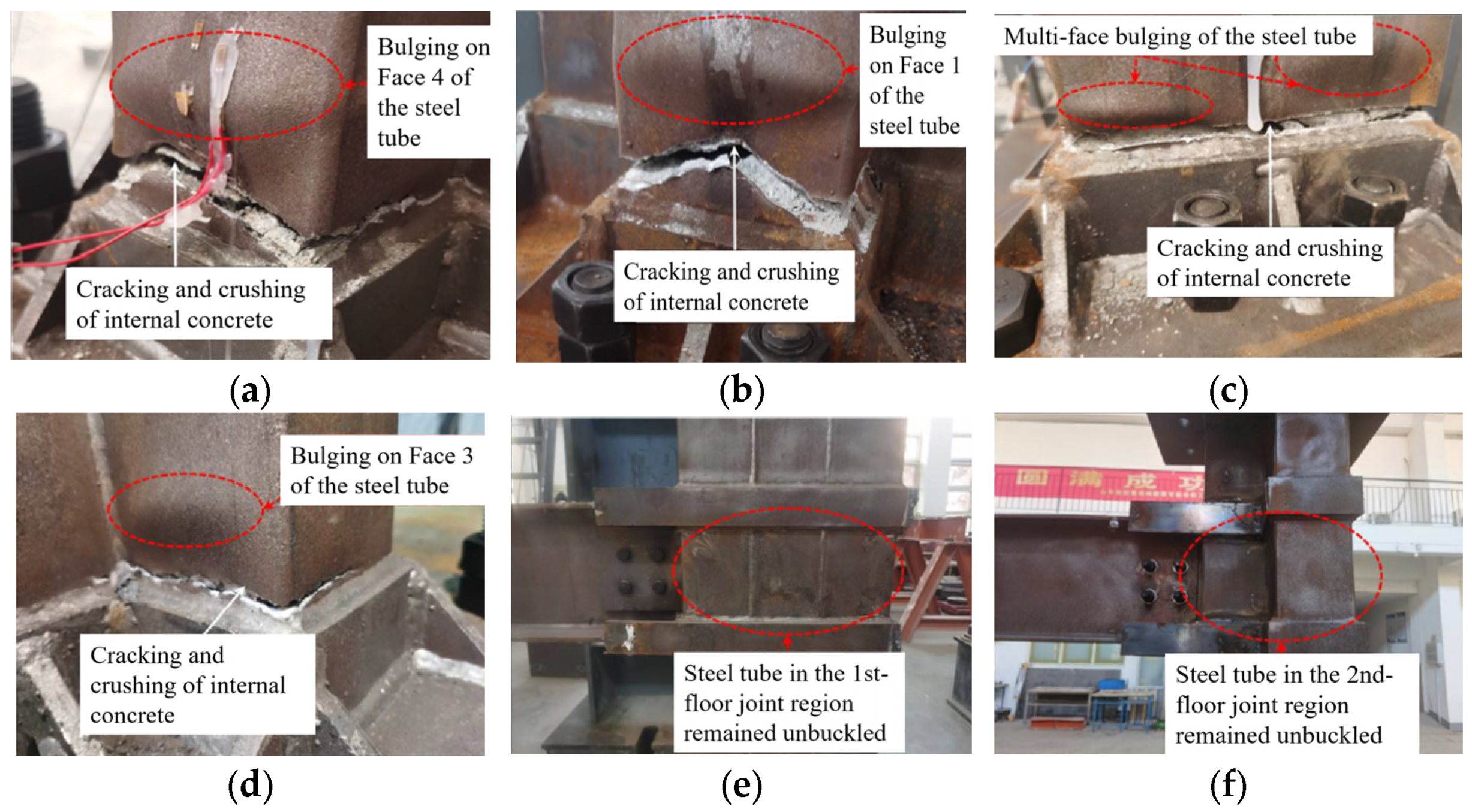
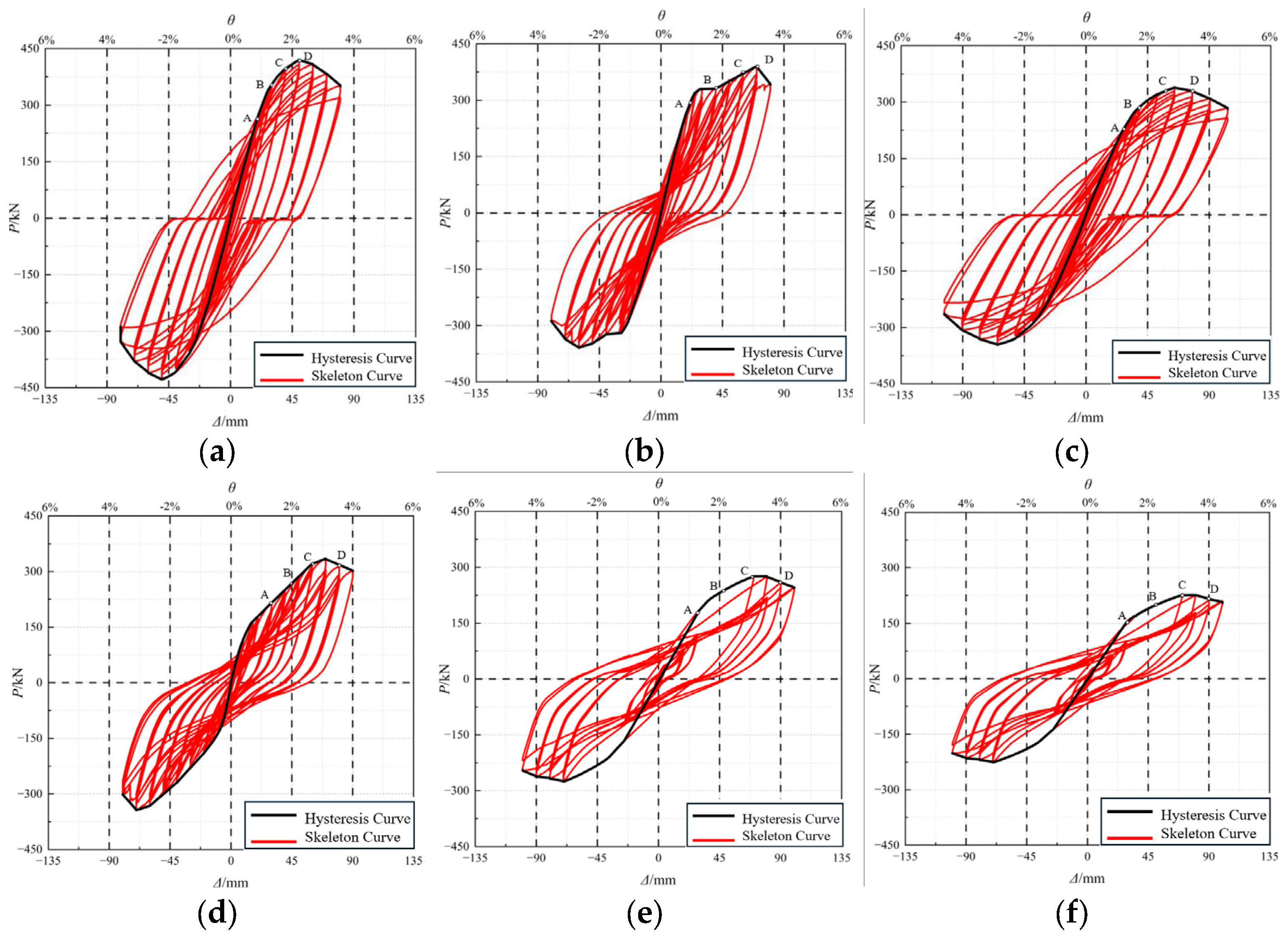
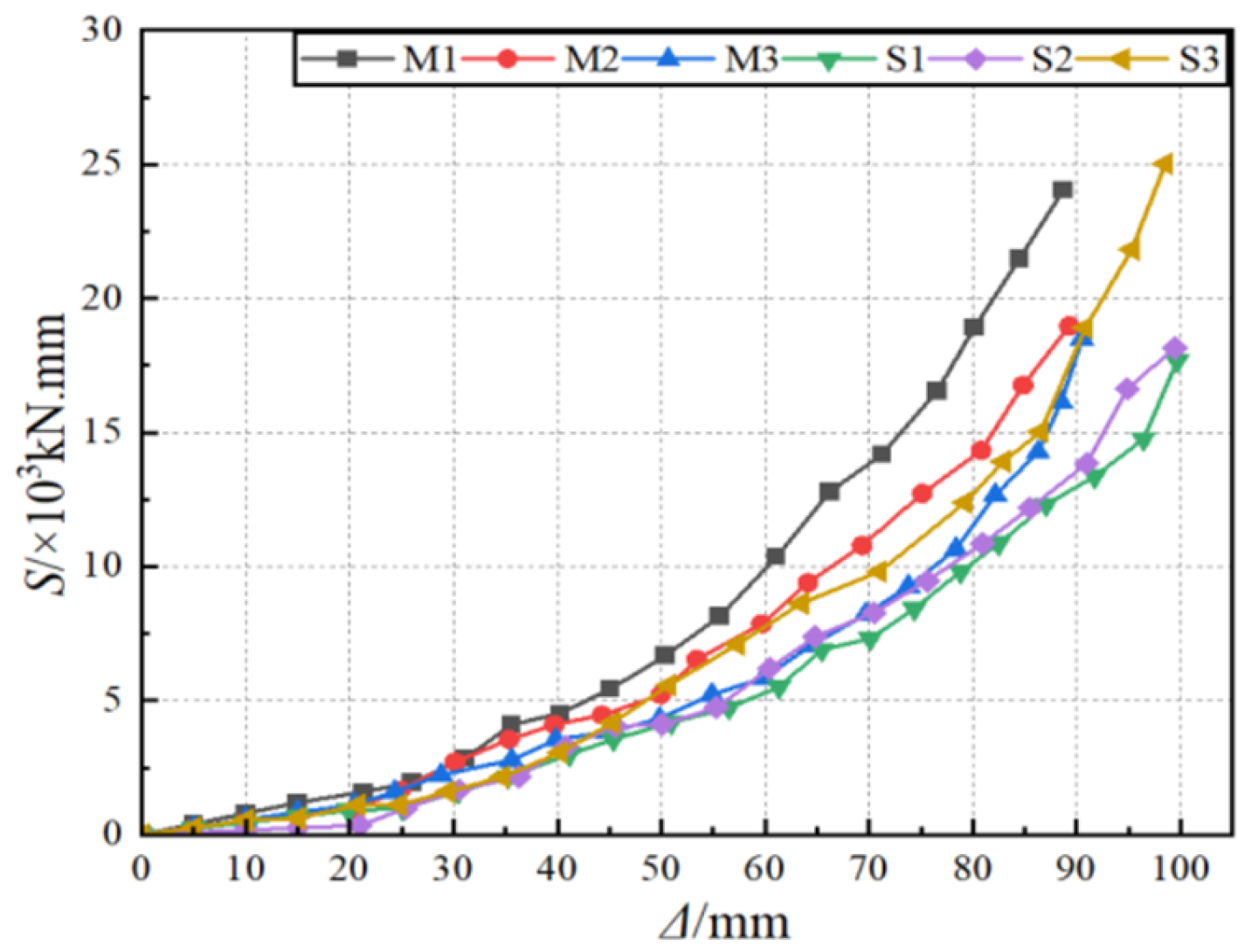
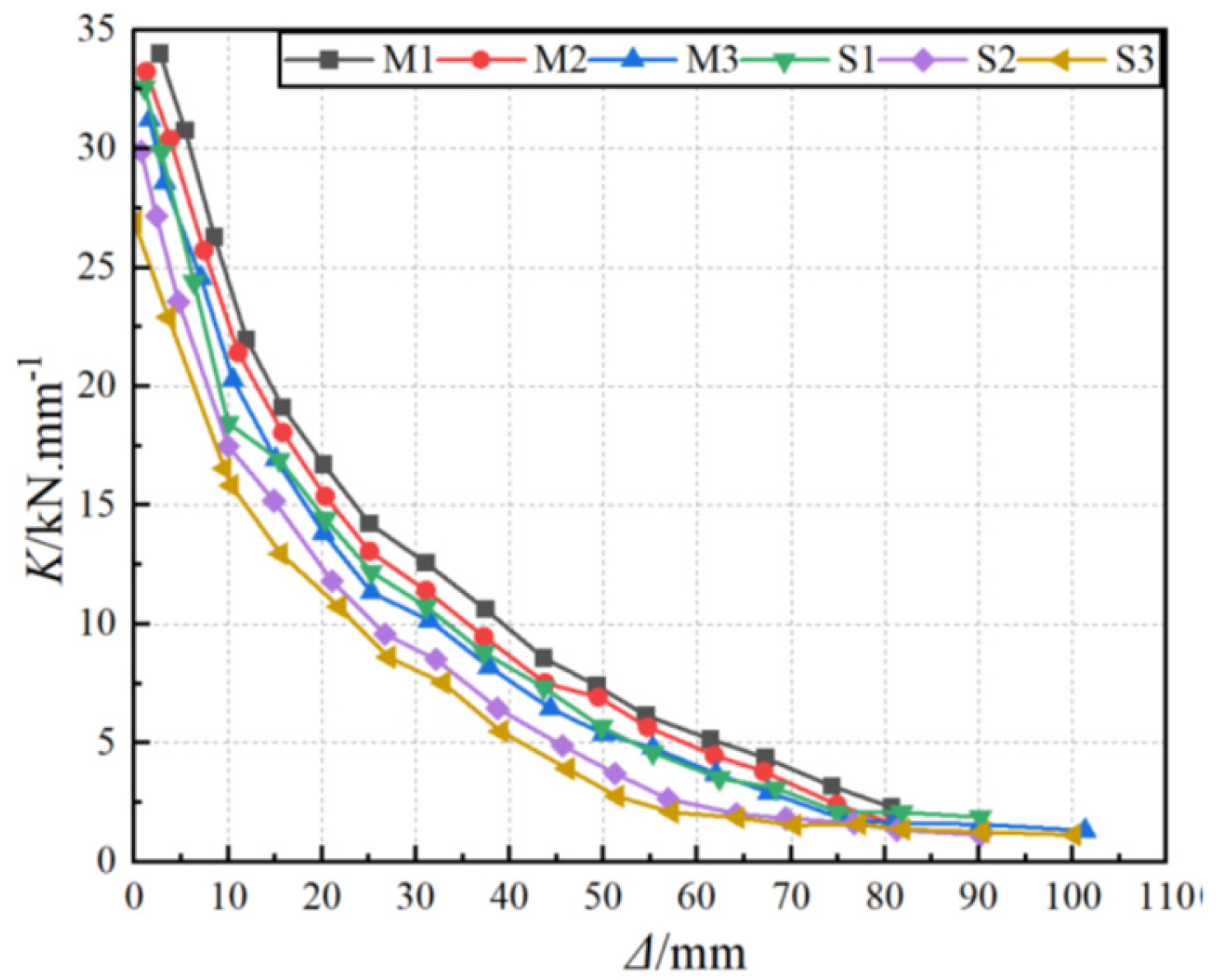
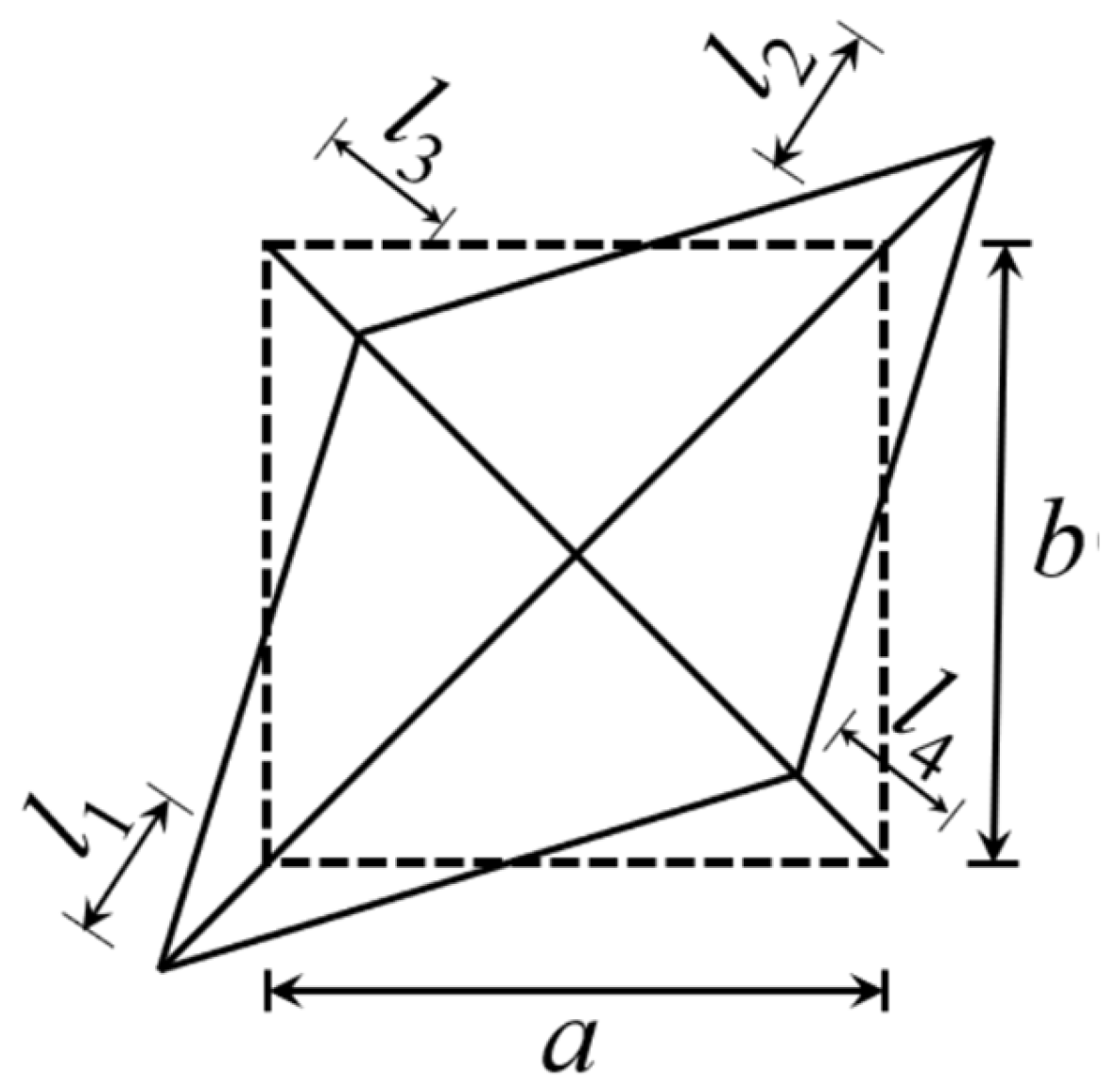
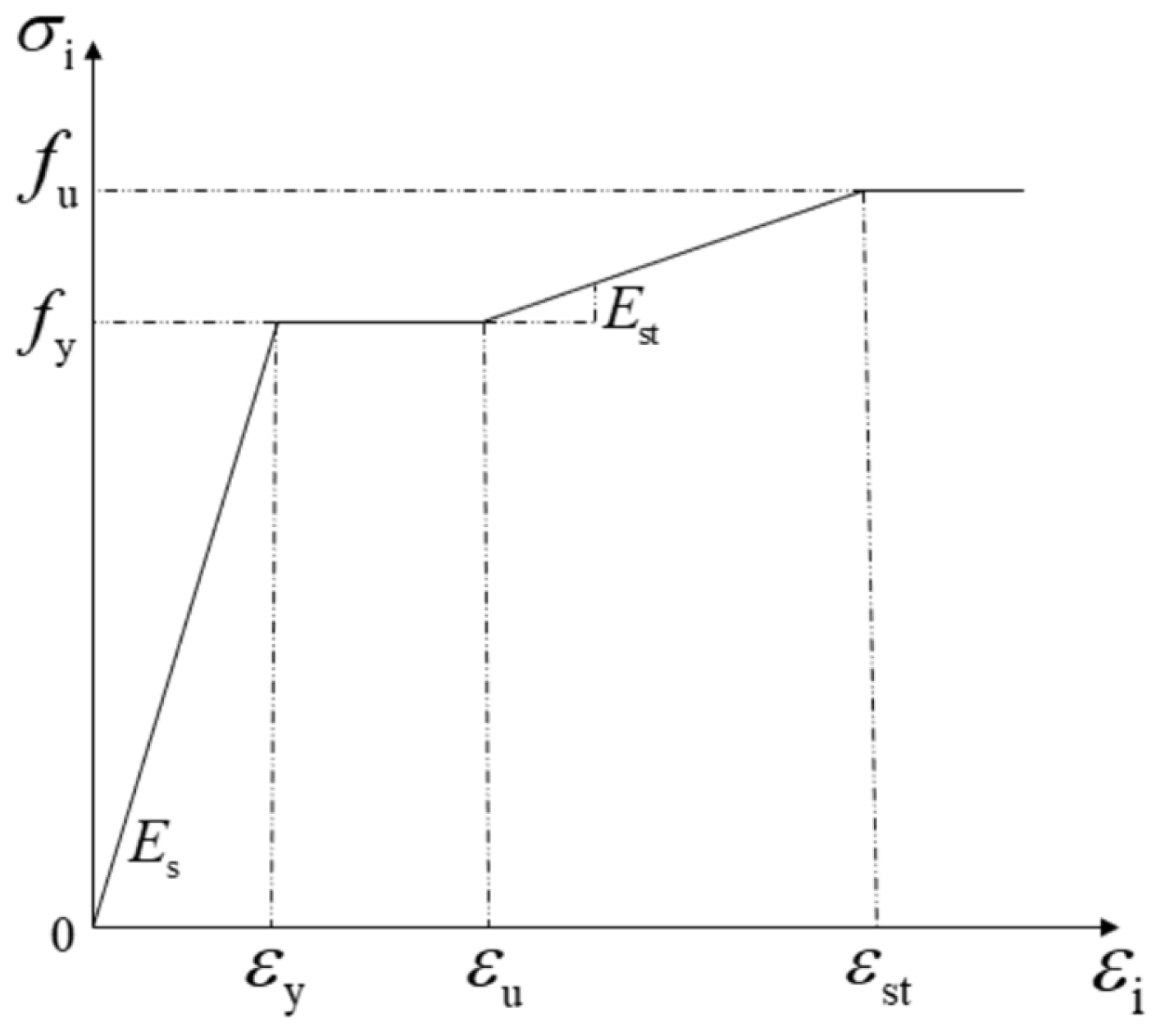

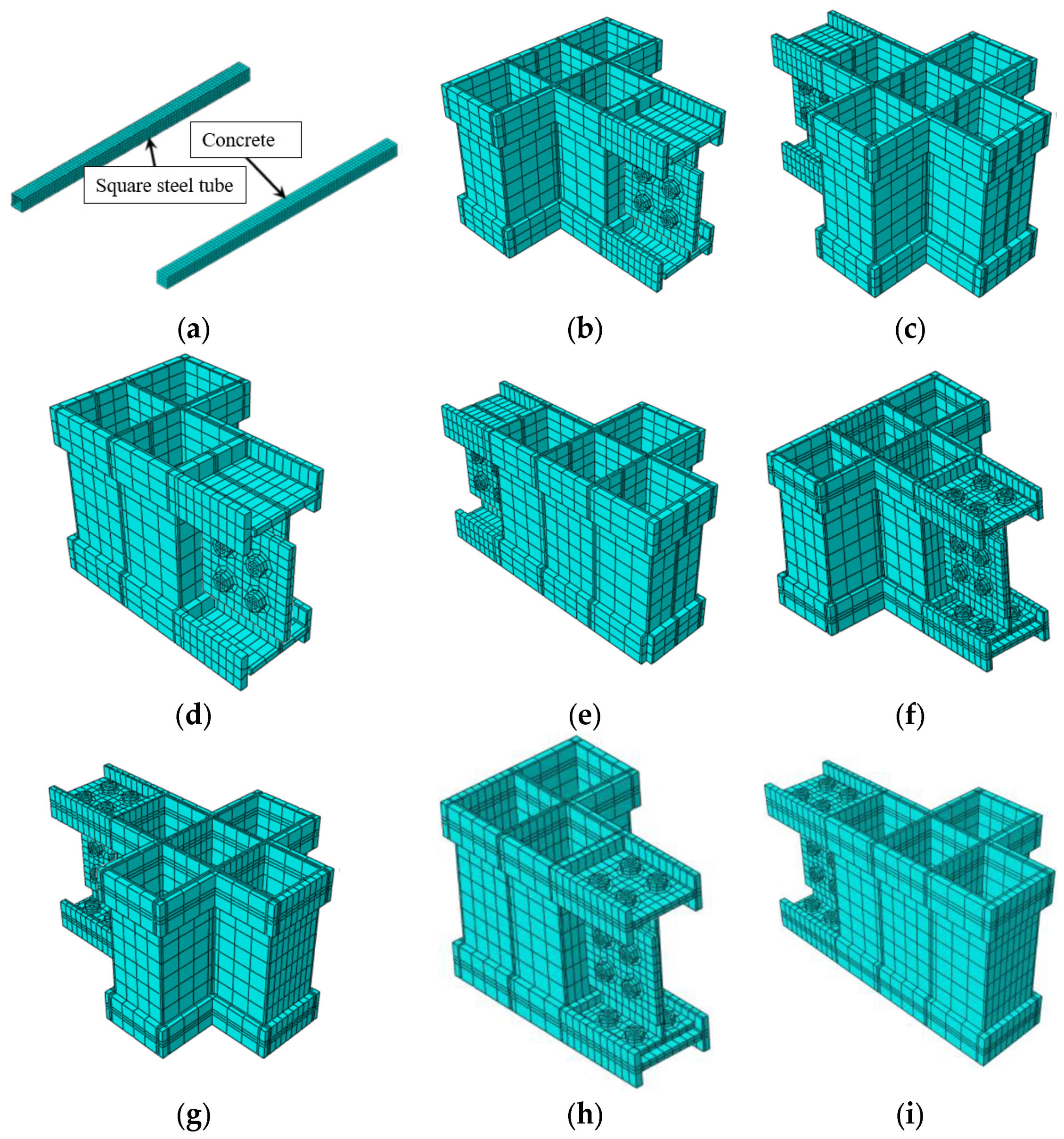
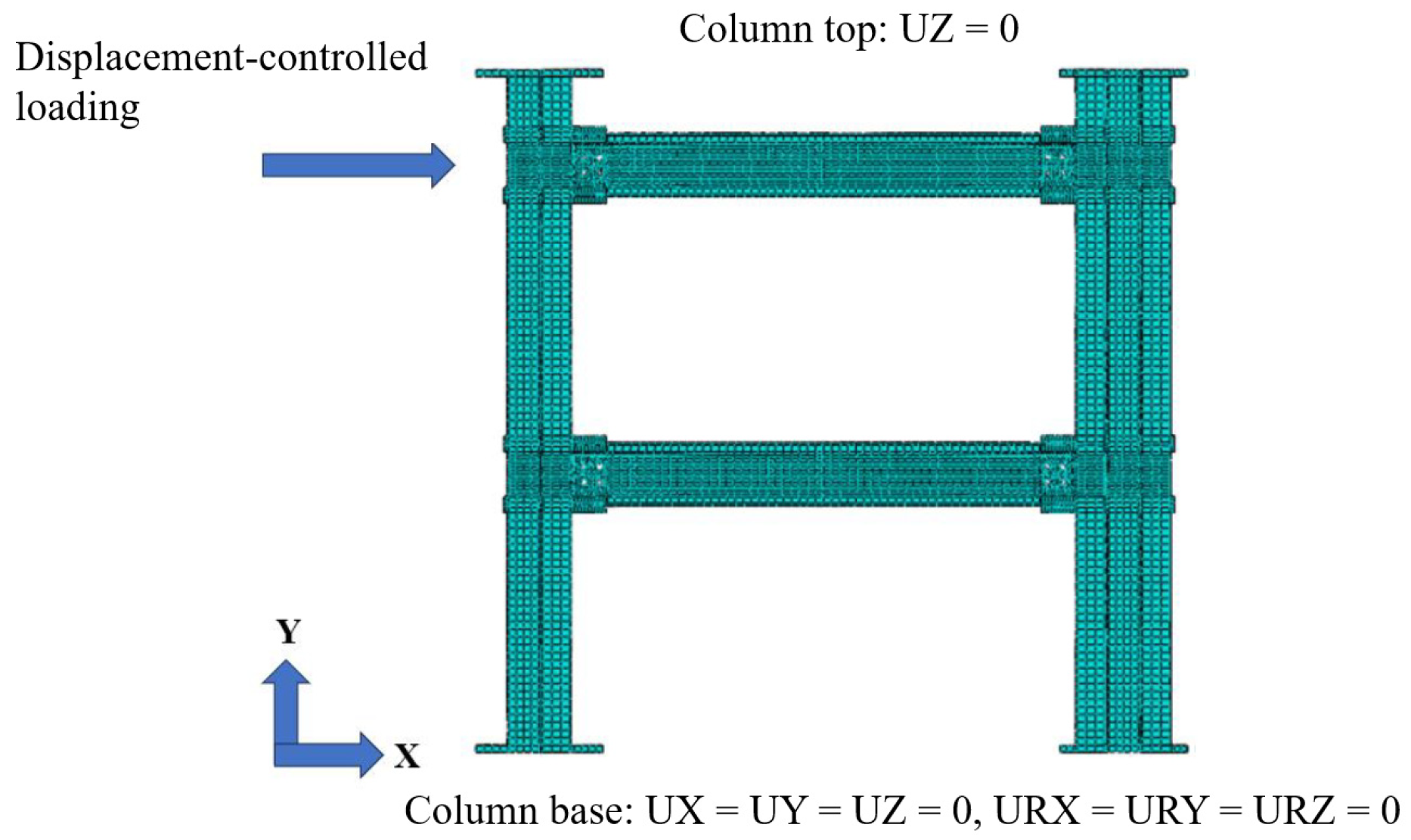
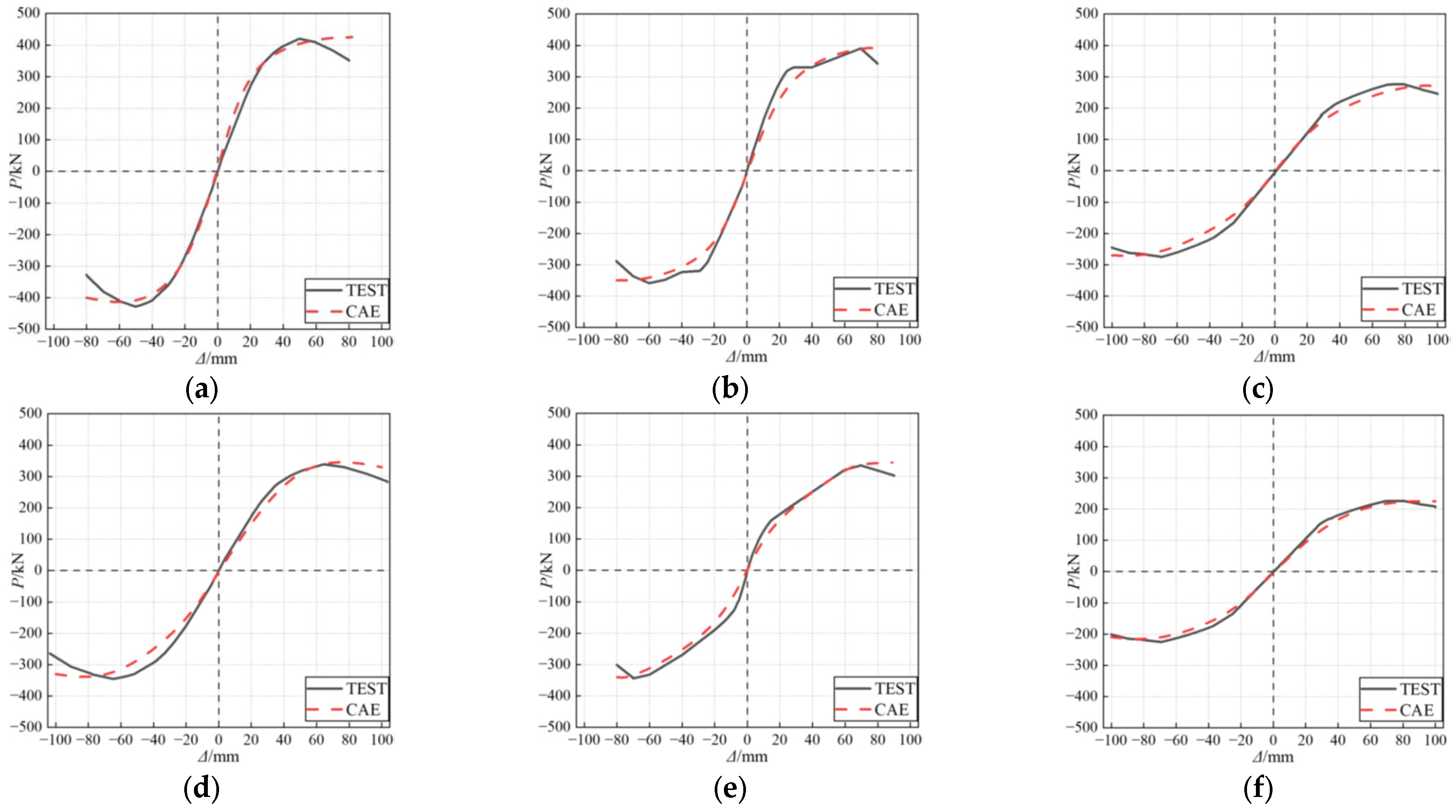
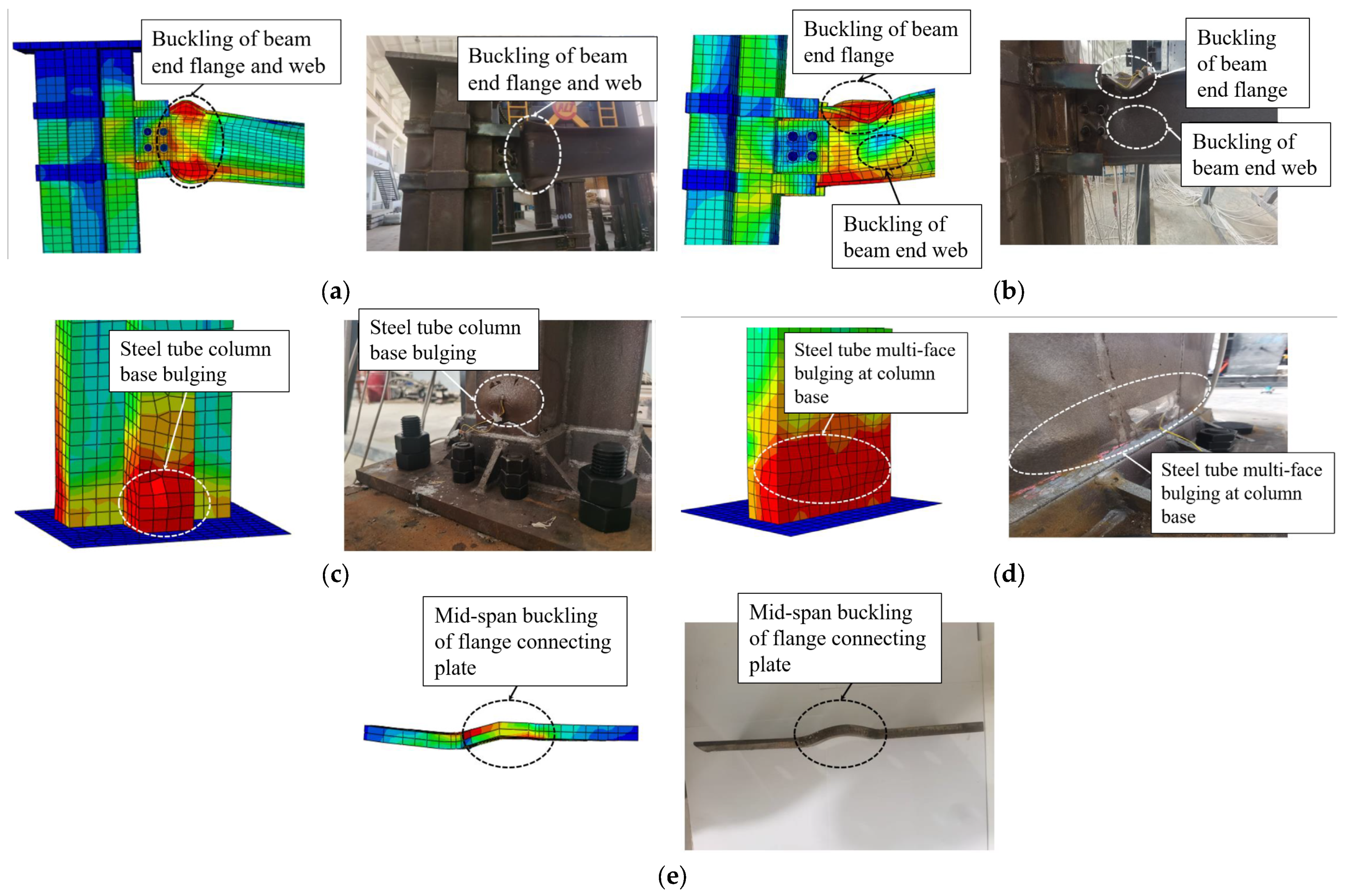


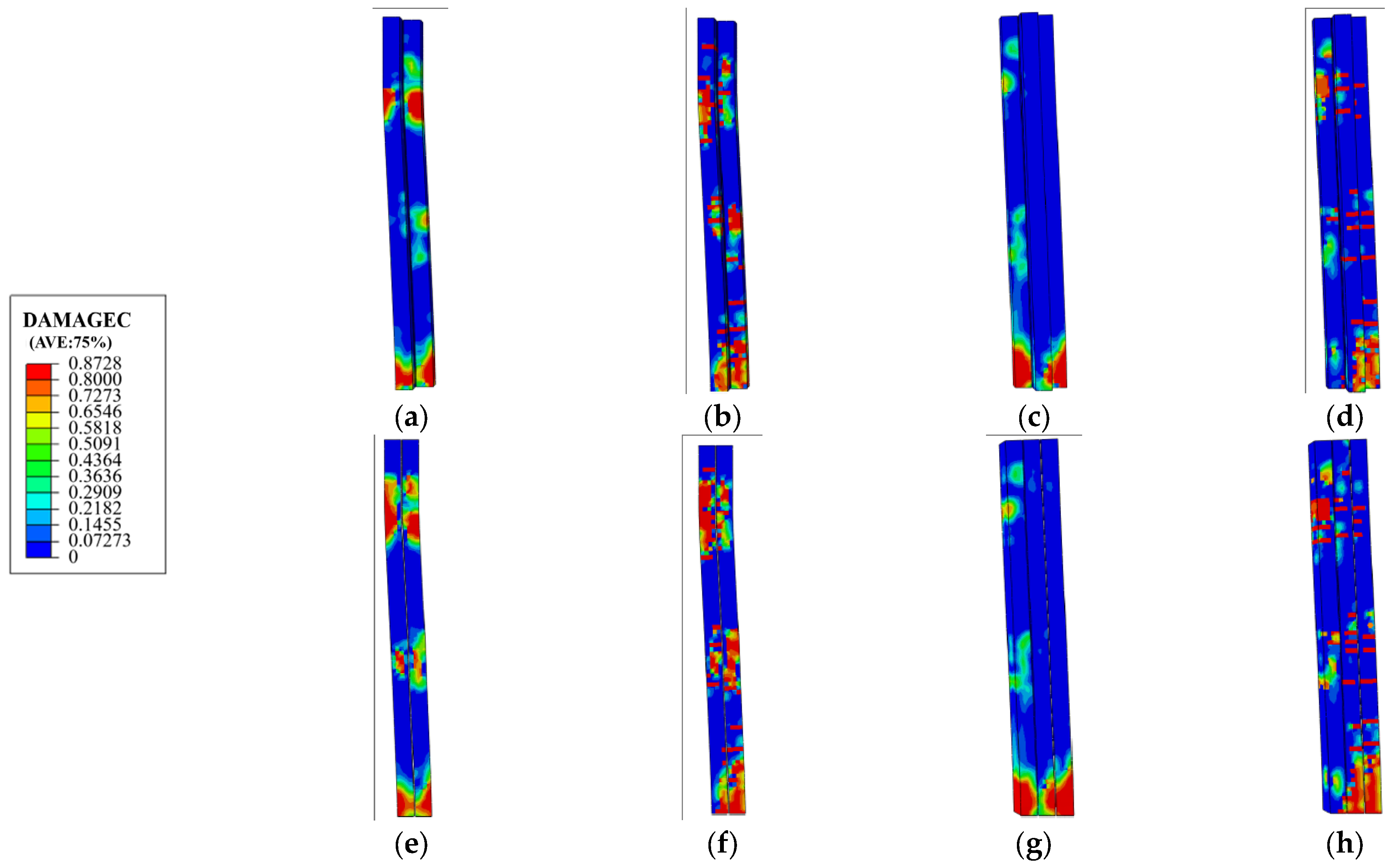
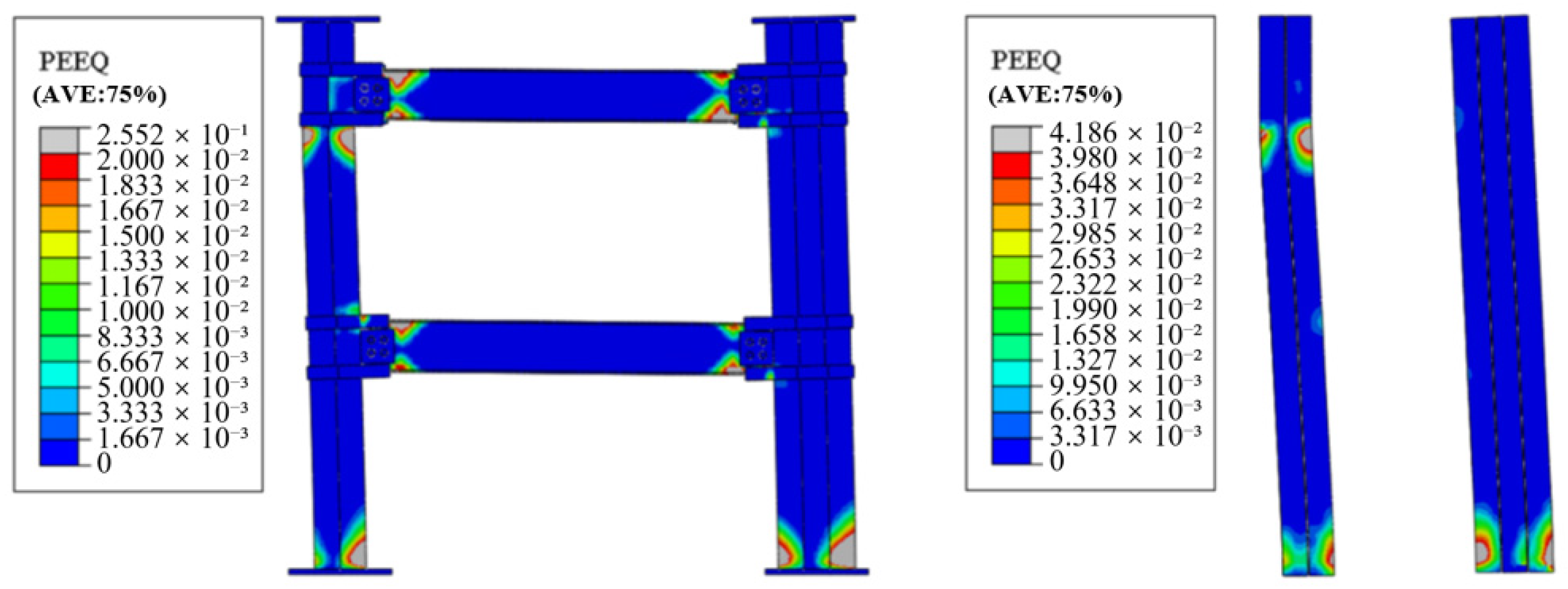


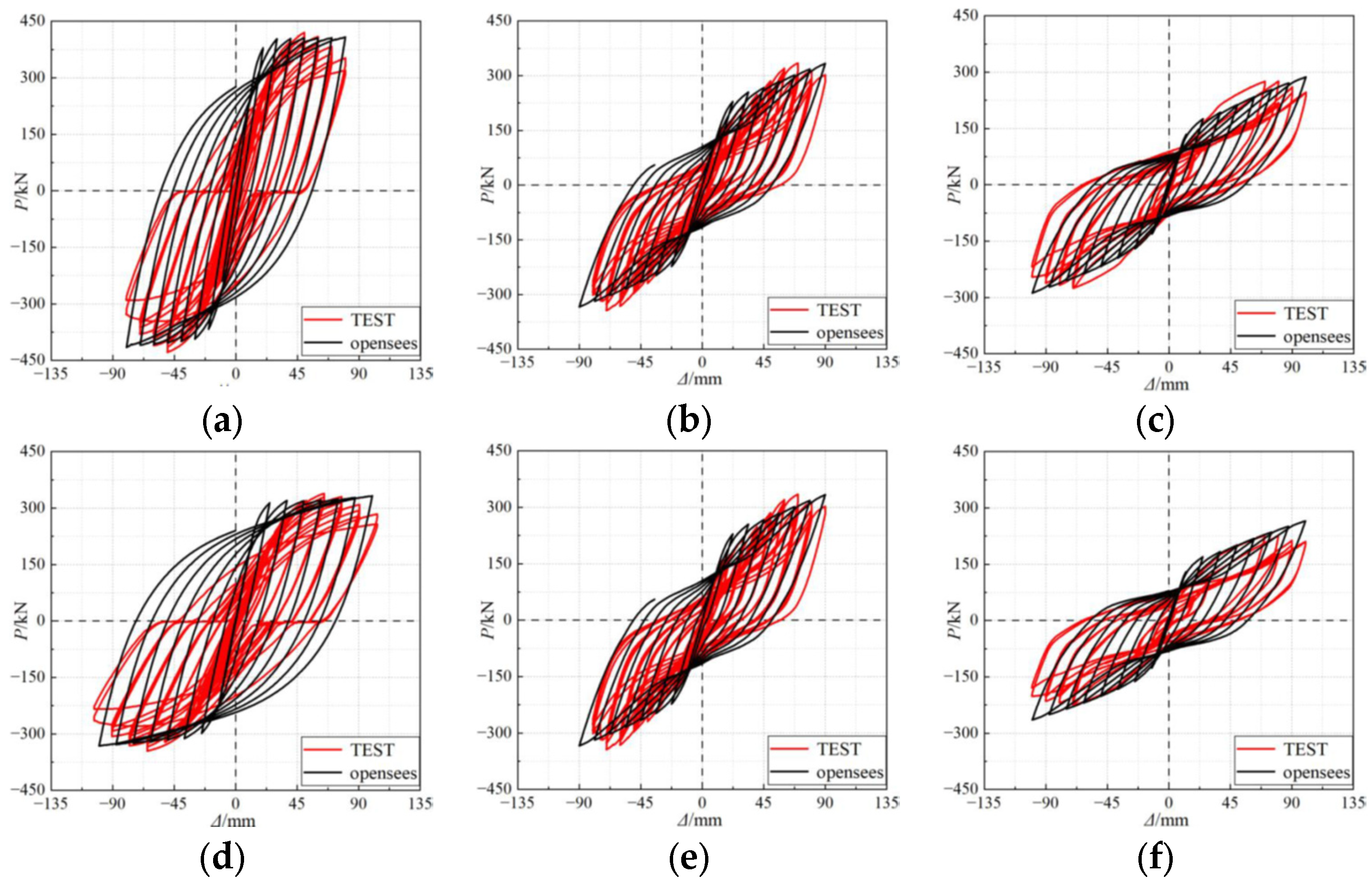

| Specimen | Steel Grade | Concrete Grade | Span (m) | Height (m) | Position | Node Type |
|---|---|---|---|---|---|---|
| M1 | Q355B | C30 | 1.85 | 2.15 | Middle | External hoop + inserted vertical rib plate |
| S1 | Q355B | C30 | 1.85 | 2.15 | Edge | External hoop + inserted vertical rib plate |
| M2 | Q355B | C30 | 1.85 | 2.15 | Middle | Fully bolted connection |
| S2 | Q355B | C30 | 1.85 | 2.15 | Edge | Fully bolted connection |
| M3 | Q355B/Q235 * | C30 | 1.85 | 2.15 | Middle | Fully bolted connection with replaceable plate |
| S3 | Q355B/Q235 * | C30 | 1.85 | 2.15 | Edge | Fully bolted connection with replaceable plate |
| Component (Sampling Location) | Steel Grade | Thickness t (mm) | Es (MPa) | fy (MPa) | με | fu (MPa) |
|---|---|---|---|---|---|---|
| Steel tube | Q355B | 3 | 2.01 × 105 | 368.6 | 1832.9 | 488.6 |
| Beam flange | Q355B | 6 | 2.06 × 105 | 386.9 | 1873.8 | 512.4 |
| Beam web | Q355B | 8 | 2.08 × 105 | 393.5 | 1891.3 | 533.8 |
| Hoops | Q355B | 10 | 2.14 × 105 | 408.5 | 1906.4 | 554.6 |
| Vertical ribs | Q355B | 10 | 2.12 × 105 | 403.4 | 1899.5 | 549.9 |
| Replaceable plate | Q235B | 10 | 2.00 × 105 | 265.9 | 1326.8 | 405.3 |
| Specimen | Node L1 | Node R1 | ||
|---|---|---|---|---|
| θa | θb | θa | θb | |
| M1 | 1.94 | 0.15 | 1.77 | 0.12 |
| M2 | 2.07 | 0.17 | 1.78 | 0.15 |
| M3 | 2.13 | 0.19 | 1.91 | 0.19 |
| S1 | 2.20 | 0.25 | 2.02 | 0.23 |
| S2 | 2.30 | 0.26 | 2.17 | 0.24 |
| S3 | 2.60 | 0.31 | 2.51 | 0.28 |
| Parameter | Description | Value |
|---|---|---|
| Dilation angle | 40° | |
| m | Flow potential eccentricity | 0.10 |
| Ratio of biaxial to uniaxial compressive strengths | 1.16 | |
| k | Deviatoric shape factor | 0.6667 |
| Viscosity parameter | 0.0005 |
| Specimen | ABAQUS MAE (kN) | ABAQUS MAPE (%) | OpenSees MAE (kN) | OpenSees MAPE (%) |
|---|---|---|---|---|
| M1 | 15.2 | 4.6 | 18.9 | 5.7 |
| M2 | 12.4 | 4.1 | 17.2 | 5.9 |
| M3 | 13.8 | 4.3 | 21.5 | 7.2 |
| S1 | 11.7 | 3.5 | 19.3 | 5.6 |
| S2 | 14.9 | 4.5 | 16.8 | 5.0 |
| S3 | 9.6 | 3.2 | 10.7 | 3.9 |
Disclaimer/Publisher’s Note: The statements, opinions and data contained in all publications are solely those of the individual author(s) and contributor(s) and not of MDPI and/or the editor(s). MDPI and/or the editor(s) disclaim responsibility for any injury to people or property resulting from any ideas, methods, instructions or products referred to in the content. |
© 2025 by the authors. Licensee MDPI, Basel, Switzerland. This article is an open access article distributed under the terms and conditions of the Creative Commons Attribution (CC BY) license (https://creativecommons.org/licenses/by/4.0/).
Share and Cite
Zhang, L.; Xia, J. Seismic Performance of Space-Saving Special-Shaped Concrete-Filled Steel Tube (CFST) Frames with Different Joint Types: Symmetry Effects and Design Implications for Civil Transportation Buildings. Symmetry 2025, 17, 1545. https://doi.org/10.3390/sym17091545
Zhang L, Xia J. Seismic Performance of Space-Saving Special-Shaped Concrete-Filled Steel Tube (CFST) Frames with Different Joint Types: Symmetry Effects and Design Implications for Civil Transportation Buildings. Symmetry. 2025; 17(9):1545. https://doi.org/10.3390/sym17091545
Chicago/Turabian StyleZhang, Liying, and Jingfeng Xia. 2025. "Seismic Performance of Space-Saving Special-Shaped Concrete-Filled Steel Tube (CFST) Frames with Different Joint Types: Symmetry Effects and Design Implications for Civil Transportation Buildings" Symmetry 17, no. 9: 1545. https://doi.org/10.3390/sym17091545
APA StyleZhang, L., & Xia, J. (2025). Seismic Performance of Space-Saving Special-Shaped Concrete-Filled Steel Tube (CFST) Frames with Different Joint Types: Symmetry Effects and Design Implications for Civil Transportation Buildings. Symmetry, 17(9), 1545. https://doi.org/10.3390/sym17091545





